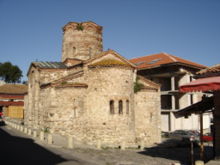
Church of John the Baptist
Encyclopedia

Bulgaria
Bulgaria , officially the Republic of Bulgaria , is a parliamentary democracy within a unitary constitutional republic in Southeast Europe. The country borders Romania to the north, Serbia and Macedonia to the west, Greece and Turkey to the south, as well as the Black Sea to the east...
.
Description
The Church of St. John the Baptist is a domed cruciform church, built of undressed stone. It is one of the best preserved churchs in Nessebar. It is 12 meters long and 10 wide. The structure of the church consists of two cylindrical vaults which intersect in the center of the composition. The masonry is crushed stone and pebbles and the facades were probably smoothly plastered. It was built in the 10th century. It has no narthexNarthex
The narthex of a church is the entrance or lobby area, located at the end of the nave, at the far end from the church's main altar. Traditionally the narthex was a part of the church building, but was not considered part of the church proper...
. The altar space consists of three semi-circular apses. Four massive pillars support the dome and form the cross. Inside the church the walls are smooth and unbroken. The exterior is simple without decorative niches and ceramic plaques, typical of the ornamental style. Bricks were used as a decorative element over the entrance, in the jagged cornices and around the windows.
Some frescoes in the church have been preserved dating from later periods. The faded portraits of the donor and his contemporaries
Donor portrait
A donor portrait or votive portrait is a portrait in a larger painting or other work showing the person who commissioned and paid for the image, or a member of his, or her, family...
on the southern wall and the fragments beneath the dome date from 14th c. and the others are from the 16th and 17th centuries. One depicts St. Marina pulling a devil from the sea before braining it with a hammer — possibly representing the local merchants' hopes that their patron would deal the Cossack pirates who raided Nessebar in the 17th Century A.D.

